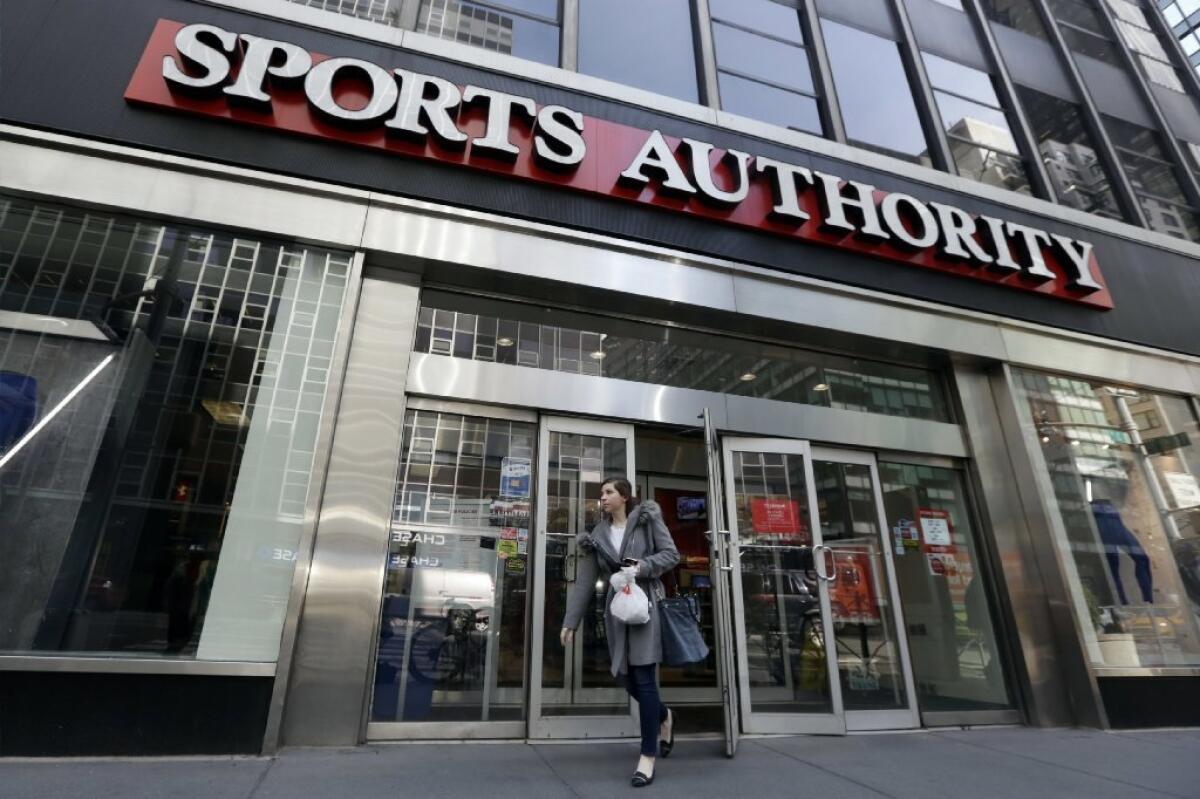When Sports Authority closes, these retailers win

Sports Authority reportedly will sell off all its assets instead of reorganizing under bankruptcy protection.
It’s a zero-sum game for bricks-and-mortar sporting goods retailers, so the demise of Sport Chalet and now Sports Authority could be a win for the few traditional players that still remain.
This month, Sport Chalet, a 57-year-old chain based in La Cañada Flintridge, said it was closing all 47 of its stores after years of financial troubles. And this week Sports Authority, which filed for bankruptcy protection in March, said it will ditch its reorganization plan and instead hold an auction for the company, potentially selling it off in pieces.
See more of our top stories on Facebook >>
The eventual buyer or buyers, however, might not want to keep stores open and could opt to liquidate the assets; when Sports Authority filed for bankruptcy, it had 463 stores nationwide and said it would close or sell about 140.
It’s the latest shake-up in a rapidly evolving sporting goods industry that is fighting off competition from mass-merchant discounters, online retailers and specialty high-end brands.
“There are more choices for the consumer now,” said Diana Smith, senior research analyst for retail and apparel at the research firm Mintel Group Ltd. “There is not enough room for everyone.”
Although the industry has splintered, a few of the longtime chains — namely Dick’s Sporting Goods, Big 5 and REI — have remained healthy and stand to gain now that the playing field is thinning out.
Their resilience is due to distinct business strategies: for Dick’s, a massive national footprint with a wide range of merchandise and niche products such as firearms; for Big 5, smaller footprint stores with a more limited assortment, but at lower prices; and for REI, a steadfast focus on customer experience.
Dick’s in particular has emerged as the dominant player for those seeking everything, said Rory Masterson, industry analyst at IbisWorld. It has also succeeded by embracing the Internet, negotiating good deals from suppliers and offering customers a high level of service through in-store experts, Masterson said.
At a time when retailers across the board have been scaling back on physical stores, Dick’s has been able to rapidly expand. In the last five years, the number of Dick’s stores jumped to 644 from 444, according to the company’s 2015 annual report.
“They’ve mastered the art of the general sporting goods store,” Masterson said.
Like Dick’s, other industry leaders such as REI and Cabela’s Inc. also established stronger relationships with suppliers and developed the kind of leverage on the supply side that smaller operators like Sport Chalet were unable to match.
Those retailers were also ahead of the curve when it came to building an online presence, which put companies that were slower at building their own websites at a disadvantage.
Dick’s could be a likely buyer for some of the Sports Authority stores, though Big 5 is likely to pass given that its outlets are far smaller, said Matt Powell, an industry analyst at market research firm NPD Group. But a good number of the Sports Authority stores are likely to close, given that more shopping is being done online, he said.
“There are far too many stores in America for the amount of business out there,” he said.
As those chains vie to snatch up the business left behind by Sport Chalet and Sports Authority, they will have to contend with newer players as well.
These days, consumers looking for sports apparel and equipment can shop online, as well as at discounters such as Wal-Mart and Target. Many style-conscious women buy pricey yoga pants and sports bras at Lululemon or Fabletics instead of hitting up the more traditional sporting goods stores, and mall-based retailers such as Gap, Forever 21 and H&M have expanded their athletic offerings to appeal to fitness-minded shoppers.
Sales in the sporting goods market in 2014 reached $63.7 billion, up 24% from 2009, according to the National Sporting Goods Assn.
Sport Chalet and Sports Authority were less equipped to weather the increased competition.
Dragged down by debt, they couldn’t make the needed investments in the business, including upgrading their stores, the NPD Group’s Powell said. When Sport Chalet — which hadn’t inked a profit since 2007 — was bought by Vestis Retail Group in 2014, it had more than $52 million in debt.
In its fiscal year ended March 30, 2014, its last as a public company, Sport Chalet lost $10 million on sales of $344 million.
A warm winter provided the “tipping point” for debt-laden Sports Authority and Sport Chalet as Americans had less of a reason to purchase skis, jackets and gloves, Powell said.
“In today’s retail world it’s very hard to operate with a high level of debt,” Powell said. “The one catalyst that pushed them over was the lack of winter in 2015.”
An attorney for Sports Authority, Robert Klyman, said the firm is seeking offers from bidders “who may want substantially all of the business and others who may want portions.” A bankruptcy court is expected to approve offers in a late May hearing after an auction.
“Sports Authority has decided that the way to maximize value of recoveries for all stakeholders is through a sale process, not a plan of reorganization,” Klyman said.
The company has 76 stores in California, according to its website; some have already been earmarked for closure.
Times staff writer James F. Peltz contributed to this report.
Twitter: @khouriandrew
MORE BUSINESS NEWS
Comcast-DreamWorks deal shaping up to be a match made in Hollywood heaven
Judge rules Sumner Redstone trial will be open to the public
SpaceX will head to Mars as soon as 2018
More to Read
Inside the business of entertainment
The Wide Shot brings you news, analysis and insights on everything from streaming wars to production — and what it all means for the future.
You may occasionally receive promotional content from the Los Angeles Times.











